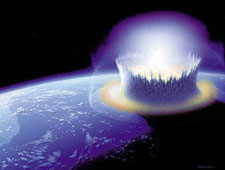News today from the National Science Foundation will have an impact on how scientists are able to study…. well, impacts. A team of geologists has developed a new way of determining the size and frequency of meteorites that have collided with Earth in the past. By studying sediments found on the ocean floor and looking for isotopes of the rare element osmium, scientists can now figure out not only when a meteorite impact occurred in Earth’s history, but also the size of the meteorite. One of the most exciting benefits of this new technique is the potential for identifying previously unknown impacts.
When meteorites collide with Earth, they carry a different osmium isotope ratio than the levels normally seen throughout the oceans.
“The vaporization of meteorites carries a pulse of this rare element into the area where they landed,” says Rodey Batiza of the National Science Foundation, which funded the research. “The osmium mixes throughout the ocean quickly. Records of these impact-induced changes in ocean chemistry are then preserved in deep-sea sediments.”
François Paquay, a geologist at the University of Hawaii at Manoa analyzed samples from two sites where core samples of the ocean floor were taken, one near the equatorial Pacific and another located off of the tip of South Africa. He measured osmium isotope levels during the late Eocene period, a time during which large meteorite impacts are known to have occurred.
“The record in marine sediments allowed us to discover how osmium changes in the ocean during and after an impact,” says Paquay.
The scientists believe this new approach to estimating impact size will become an important complement to a more well-known method based on iridium.
Paquay’s team also used this method to make estimates of impact size at the Cretaceous-Tertiary (K-T) boundary 65 million years ago. Since the osmium carried by meteorites is dissolved in seawater, the geologists were able to use their method to estimate the size of the K-T meteorite as four to six kilometers in diameter. The meteorite was the trigger, scientists believe, for the mass extinction of dinosaurs and other life forms.
But Paquay doesn’t believe this method will work for events larger than the K-T impact. With such a large meteorite impact, the meteorite contribution of osmium to the oceans would overwhelm existing levels of the element, making it impossible to sort out the osmium’s origin.
But it will be interesting to follow this to see if new, unknown impacts in Earth’s history can be discovered.
Original News Source: Eureka Alert


There have been proposals that local small impacts may cause local extinctions. If this can detect small impacts, it should be interesting to see the correlations or lack thereof.
The technique assumes that all of the osmium dissolves into the seawater. If some of the meteorite did not dissolve, then this tool would give a lower mass figure. If the meteor had a higher than average iron component, the result would be less. It assumes that the osmium concentration matches meteors we find today. If one assumption were off slightly, the resulting value returned would be close. If one of them varied a great deal, then the answer would be wrong. If several assumptions were all off slightly in the same direction, then again the answer would be wrong. Considering the substantial undervalue of the Chixculub impact object, it might be better to treat this technique as being able to set a probable lower mass limit rather than a specific size.